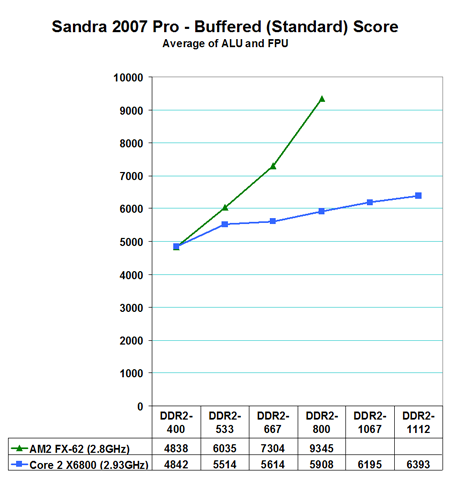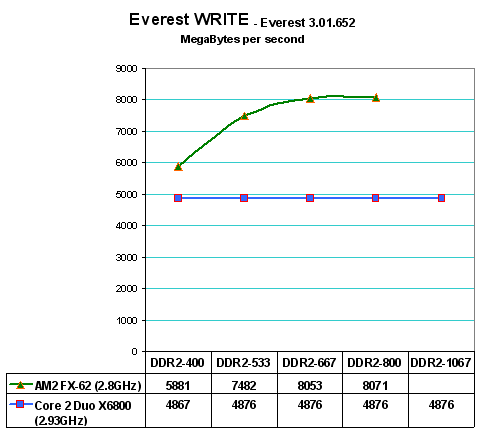Memory Bandwidth and Scaling
Everyone should already know that memory bandwidth improves with increases in memory speed and reductions in memory timings. To better understand the behavior of AM2 and Core 2 Duo memory bandwidth we used SiSoft Sandra 2007 Professional to provide a closer look at memory bandwidth scaling.

The most widely reported Sandra score is the Standard or Buffered memory score. This benchmark takes into account the buffering schemes like MMX, SSE, SSE2, SSE3, and other buffering tools that are used to improve memory performance. As you can clearly see in the Buffered result the AM2 on-chip memory controller holds a huge lead in bandwidth over Core 2 Duo. At DDR2-800 the AM2 lead in memory bandwidth is over 40%.
As we have been saying for years, however, the Buffered benchmark does not correlate well with real performance in games on the same computer. For that reason, our memory bandwidth tests have always included an UNBuffered Sandra memory score. The UNBuffered result turns off the buffering schemes, and we have found the results correlate well with real-world performance.

The Intel Core 2 Duo and AMD AM2 behave quite differently in UNBuferred tests. In these results AM2 and Core2 Duo are very close in memory bandwidth - much closer than in Standard tests. Core 2 Duo shows wider bandwidth below DDR2-800, but this will likely change when the AM2 controller matures and supports values below 3 in memory timings as the Core 2 Duo currently supports.
The Sandra memory score is really made up of both read and write operations. By taking a closer look at the Read and Write components we can get a clearer picture of how the two memory controllers operate. Everest from Lavalys provides benchmarking tools that can individually measure Read and Write operations.

The READ results are particularly interesting, since you can see that the READ component of Core 2 Duo performance is much larger than the WRITE results on Core 2 Duo. This is the result of the intelligent read-aheads in memory which Intel has used to lower the apparent latency of memory on the Core 2 Duo platform. Actual READ performance on Core 2 Duo now looks almost the same as AM2 to DDR2-533. AM2 starts pulling away in READ at DDR2-677 and has a slightly steeper increase slope as memory speed increases. The increases in READ speed in Core 2 Duo are a result of the intelligent read-aheads in memory. Performance without this feature would show Core 2 Duo much slower in READ operations than AM2.

This is most clearly illustrated by looking at Everest Write scores. Memory read-ahead does not help when you are writing memory, so core 2 Duo exhibits much lower WRITE performance than AM2 as we would expect. This means if all else were equal (and it isn't) the AM2 would perform much better in Memory Write tasks. Surprisingly the WRITE component of Core 2 Duo appears a straight line just below 5000 MB/s. AM2 starts at 5900 at DDR2-400 and WRITE rises to around 8000MB/s at DDR2-667. Write then appears to level off, with higher memory speeds having little to no impact on AM2 WRITE performance.
Everyone should already know that memory bandwidth improves with increases in memory speed and reductions in memory timings. To better understand the behavior of AM2 and Core 2 Duo memory bandwidth we used SiSoft Sandra 2007 Professional to provide a closer look at memory bandwidth scaling.

The most widely reported Sandra score is the Standard or Buffered memory score. This benchmark takes into account the buffering schemes like MMX, SSE, SSE2, SSE3, and other buffering tools that are used to improve memory performance. As you can clearly see in the Buffered result the AM2 on-chip memory controller holds a huge lead in bandwidth over Core 2 Duo. At DDR2-800 the AM2 lead in memory bandwidth is over 40%.
As we have been saying for years, however, the Buffered benchmark does not correlate well with real performance in games on the same computer. For that reason, our memory bandwidth tests have always included an UNBuffered Sandra memory score. The UNBuffered result turns off the buffering schemes, and we have found the results correlate well with real-world performance.

The Intel Core 2 Duo and AMD AM2 behave quite differently in UNBuferred tests. In these results AM2 and Core2 Duo are very close in memory bandwidth - much closer than in Standard tests. Core 2 Duo shows wider bandwidth below DDR2-800, but this will likely change when the AM2 controller matures and supports values below 3 in memory timings as the Core 2 Duo currently supports.
The Sandra memory score is really made up of both read and write operations. By taking a closer look at the Read and Write components we can get a clearer picture of how the two memory controllers operate. Everest from Lavalys provides benchmarking tools that can individually measure Read and Write operations.

The READ results are particularly interesting, since you can see that the READ component of Core 2 Duo performance is much larger than the WRITE results on Core 2 Duo. This is the result of the intelligent read-aheads in memory which Intel has used to lower the apparent latency of memory on the Core 2 Duo platform. Actual READ performance on Core 2 Duo now looks almost the same as AM2 to DDR2-533. AM2 starts pulling away in READ at DDR2-677 and has a slightly steeper increase slope as memory speed increases. The increases in READ speed in Core 2 Duo are a result of the intelligent read-aheads in memory. Performance without this feature would show Core 2 Duo much slower in READ operations than AM2.

This is most clearly illustrated by looking at Everest Write scores. Memory read-ahead does not help when you are writing memory, so core 2 Duo exhibits much lower WRITE performance than AM2 as we would expect. This means if all else were equal (and it isn't) the AM2 would perform much better in Memory Write tasks. Surprisingly the WRITE component of Core 2 Duo appears a straight line just below 5000 MB/s. AM2 starts at 5900 at DDR2-400 and WRITE rises to around 8000MB/s at DDR2-667. Write then appears to level off, with higher memory speeds having little to no impact on AM2 WRITE performance.










118 Comments
View All Comments
Zebo - Tuesday, July 25, 2006 - link
Nice one Wes and it makes sense no matter what to have memory testing done on the top dog platform, Conroe.Mclendo06 - Tuesday, July 25, 2006 - link
Is there any reason that either company, Intel or AMD, couldn't design a future processor both with an intelligent pre-fetching algorithm such as is seen in the Core 2 Duo and an on-die memory controller like on the AM2 processors? Seems like the apparent memory latencies could be dropped very significantly by combining these features.Calin - Tuesday, July 25, 2006 - link
We are hoping in the next big update to AMD processor (the K8L) to have some kind of intelligent prefetching (it is entirely possible, but it costs a number of transistors). Possibly that "intelligent prefetching" means reordering loads from memory, and this happens before the memory controllerIngas - Tuesday, July 25, 2006 - link
How can Core 2 Duo do prefetch before memory controller?
I miss some point, do I?
Calin - Wednesday, July 26, 2006 - link
I wasn't clear enough. The memory controller gets requests for memory, and returns that memory. Nothing more, nothing less.All the logic for preordering is housed in the proper microprocessor, and not in the memory controller - as such, it has no relation with the integrated/discrete implementation of the memory controller.
vailr - Tuesday, July 25, 2006 - link
Has anyone run: a Core2 Duo CPU comparison of DDR vs. DDR2, running on the ASrock 775Dual-VSTA? To determine how much slowdown would occur, by using the older DDR memory?Ingas - Tuesday, July 25, 2006 - link
Interesting point!Maybe Core intelligent look-ahead so intelligent, that it even performs equaly on DDR!
Hm.
Very interesting!
Gary Key - Tuesday, July 25, 2006 - link
We will show this in our review. ASRock just released bios 1.4 that addressed a few issues we noticed in our preview of the board.photoguy99 - Tuesday, July 25, 2006 - link
...that AMD is thoroughly owned.It's amazing the arguments have still persisted up until now about excuses for Core2 doing so well.
It was mentioned that AMD survived before at the lower end of the market - but remember how much trouble they had? There were losing money all the time back then. Now they have taken *all* of their 2.5B cash reserve and spent it on ATI. Nice.
It hurt AMD's credibility even more when Dirk Diggler recently said 4x4 was going to be an answer to Core2. Right. After 30 years of dual socket systems being a niche they are finally going to take off and save you - good luck with that.
duploxxx - Tuesday, July 25, 2006 - link
because you have no idea what is going behind the scene and only looking at performance of a desktop cpu and think this is the real world.almost no review site is proud enough to get up against the hyping marketing machine from intel. well then believe the marketing hype and own a cpu that has a crapy design when it comes to real multithread and 64bit. way to go to the future knowing vista is comming your way.
multicore/multisocket is the future, even intel knows it.
amd is in a much stronger position know and by the end of this year the make procs with a price tag 50% lower than intel intel can only counter this by going to 45nm end of 2007. knowing the cost of all the intel crew, fabs and size of the processors.